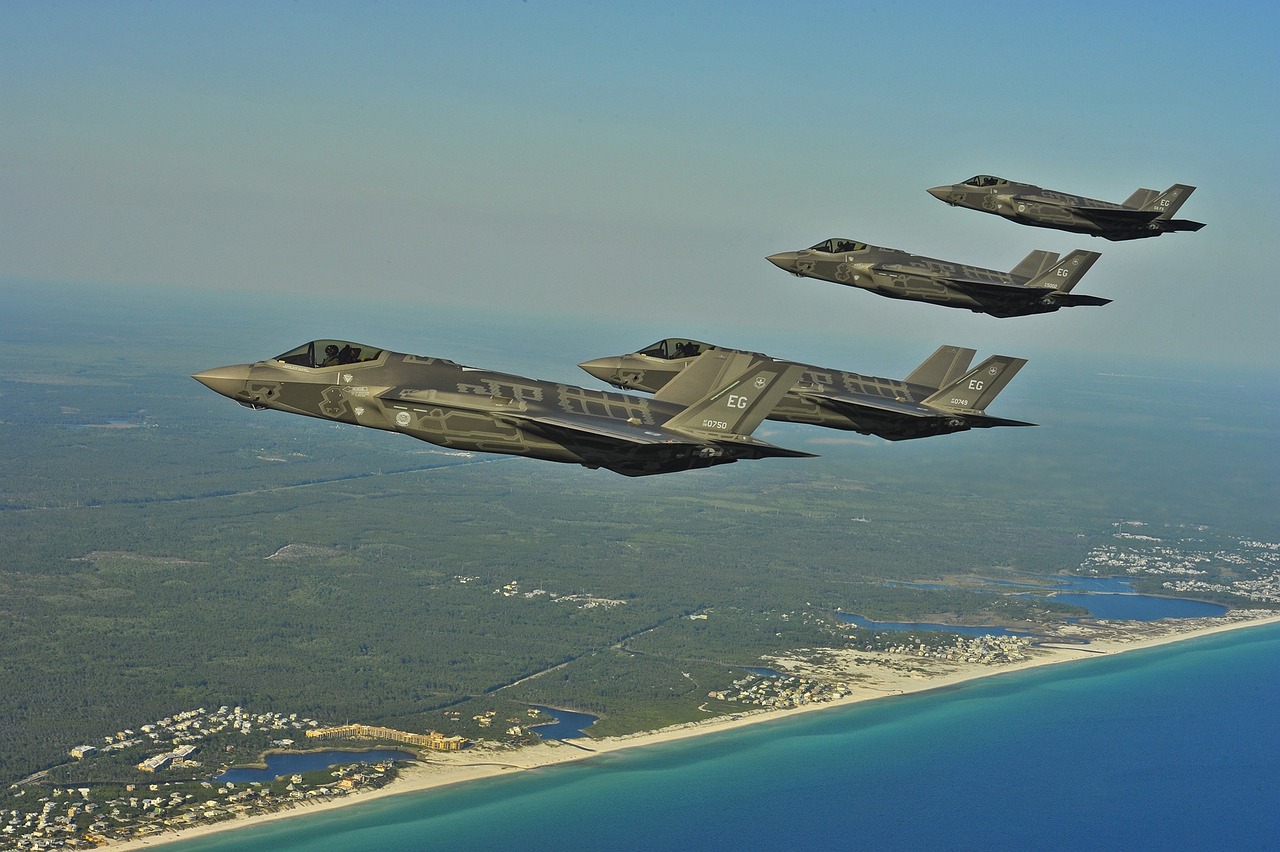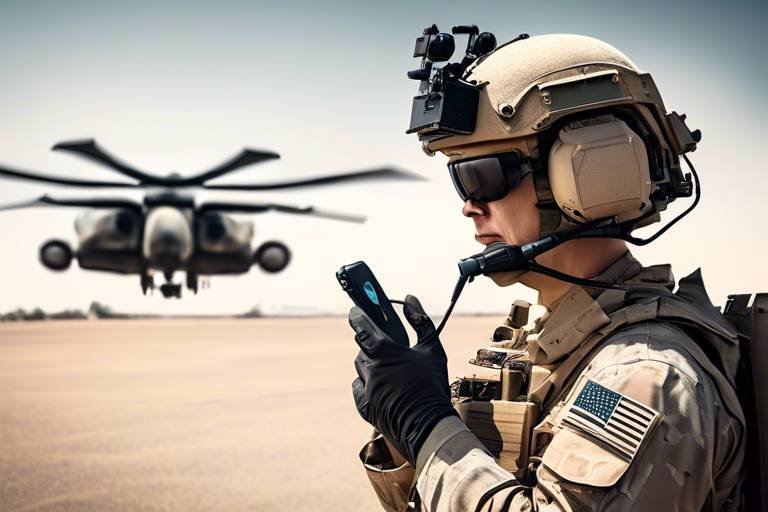The Role of AI in Streamlining Military Supply Chains
In the fast-paced world of military operations, the efficiency of supply chains can make or break a mission. Imagine a scenario where troops are deployed, but critical supplies are delayed due to outdated logistics processes. It’s a nightmare, right? This is where artificial intelligence (AI) steps in, acting as a game-changer in enhancing the efficiency, reducing costs, and improving decision-making within military supply chains. By leveraging advanced algorithms and data analytics, AI transforms logistics operations, ensuring that military personnel have the right resources at the right time, all while minimizing waste and maximizing readiness.
The integration of AI into military supply chains is akin to upgrading from a flip phone to the latest smartphone. Just as smartphones have revolutionized communication, AI is revolutionizing logistics. It empowers military organizations to predict needs, automate processes, and make data-driven decisions that were once thought impossible. With AI, the military can navigate the complexities of supply chains with greater agility and precision, ensuring that every soldier has what they need to succeed in their mission.
Let’s break down how AI achieves this transformation. First off, AI utilizes predictive analytics to forecast future needs based on historical data. This means that instead of waiting for supplies to run low, military planners can anticipate demand and adjust their procurement strategies accordingly. They can identify trends and patterns, ensuring that resources are allocated efficiently and effectively.
Another critical aspect of AI's role in military supply chains is the automation of processes. By automating routine tasks, such as inventory management and order processing, AI reduces the likelihood of human error and speeds up operations. Imagine a supply chain that runs like a well-oiled machine, where every component works in harmony, and delays are minimized. This level of efficiency is not just a dream; it’s a reality made possible by AI.
Moreover, AI enhances decision-making capabilities by providing real-time insights and recommendations. In the military, where conditions can change in an instant, having access to timely information is crucial. AI tools analyze vast amounts of data, allowing military leaders to make informed decisions quickly. It’s like having a tactical advisor at their fingertips, ready to offer guidance based on the latest intelligence.
To illustrate the impact of AI on military supply chains, let’s look at some case studies. Various defense organizations have successfully integrated AI into their logistics operations, resulting in significant improvements in efficiency and effectiveness. These real-world applications serve as a testament to the transformative power of AI in military supply chains, showcasing how technology can enhance operational readiness and support mission success.
In conclusion, the role of AI in streamlining military supply chains is undeniable. By enhancing efficiency, reducing costs, and improving decision-making, AI not only transforms logistics operations but also plays a vital role in ensuring that military personnel are prepared for any challenge. As technology continues to evolve, the military's reliance on AI will only grow, paving the way for a future where supply chains are smarter, faster, and more resilient than ever before.
- How does AI improve military supply chain efficiency?
AI improves efficiency by automating processes, predicting demand, and providing real-time data analysis, which minimizes delays and optimizes resource allocation. - What are predictive analytics?
Predictive analytics involves using historical data to forecast future needs and trends, allowing military planners to allocate resources more effectively. - Can AI completely eliminate human error in supply chains?
While AI significantly reduces human error, it is unlikely to eliminate it entirely. However, it can enhance accuracy and efficiency in supply chain operations. - What are some challenges of implementing AI in military logistics?
Challenges include data accuracy, integration with existing systems, and the need for training personnel to use AI tools effectively.

Understanding Military Supply Chains
Military supply chains are the backbone of defense operations, ensuring that troops have the necessary resources to perform their duties effectively. These supply chains encompass a complex web of processes involving the acquisition, storage, and distribution of various materials, ranging from ammunition and food to medical supplies and advanced technology. Understanding these intricacies is crucial to appreciate the transformative role that artificial intelligence (AI) plays in enhancing efficiency within military logistics.
At the heart of military supply chains lies the need for **timeliness** and **accuracy**. Imagine a scenario where a military unit is deployed to a remote location. Without a well-coordinated supply chain, the troops could find themselves lacking essential supplies, which can jeopardize missions and endanger lives. This is where AI comes into play, acting as a catalyst for change by streamlining operations and ensuring that every resource is accounted for and delivered when needed.
The complexity of military supply chains can be attributed to several factors, including the diverse range of products needed, the geographic spread of military operations, and the unpredictable nature of warfare. Each of these factors presents unique challenges that require innovative solutions. For instance, consider the following elements that define military supply chains:
- Logistics Planning: This involves strategizing how to move resources from point A to point B efficiently.
- Inventory Management: Keeping track of supplies to avoid shortages or overstock situations.
- Supplier Coordination: Collaborating with various suppliers to ensure timely delivery of goods.
- Transport Management: Utilizing various modes of transport to deliver supplies to the front lines.
The dynamic nature of military operations necessitates a supply chain that can adapt quickly to changing circumstances. AI technologies can analyze vast amounts of data in real-time, allowing military planners to make informed decisions on the fly. This adaptability is crucial, especially in high-stakes environments where every second counts.
In summary, understanding military supply chains is not just about recognizing the flow of materials; it’s about grasping the strategic importance of logistics in military success. As we delve deeper into the impact of AI on these supply chains, it becomes evident that the integration of advanced technologies is not merely an enhancement but a necessity for modern military operations.

The Impact of AI on Logistics
Artificial Intelligence (AI) is not just a buzzword; it's a game changer in the world of logistics, especially within military supply chains. Imagine a vast network of resources, vehicles, and personnel all working together seamlessly. This is the vision that AI helps to realize by enhancing efficiency, reducing costs, and improving decision-making. The integration of AI technologies into military logistics operations is akin to adding a turbocharger to an already powerful engine—everything runs smoother and faster.
One of the most significant impacts of AI on logistics is its ability to automate mundane and repetitive tasks. Think about how much time is wasted on manual inventory checks or route planning. With AI, these tasks can be automated, freeing up personnel to focus on more strategic activities. For instance, AI algorithms can analyze vast amounts of data to determine the most efficient routes for supply deliveries, ensuring that resources reach their destinations on time and at the lowest possible cost. This not only saves money but also enhances operational readiness, which is critical in military contexts.
Furthermore, AI excels at predictive analytics, which is crucial for anticipating future logistical needs. By analyzing historical data, AI can forecast demand for various resources, allowing military planners to allocate supplies more effectively. This leads to reduced wastage and ensures that troops have what they need when they need it. In essence, AI acts like a crystal ball, providing insights that help military leaders make informed decisions.
Another area where AI shines is in real-time data analysis. In the fast-paced environment of military operations, timely information is everything. AI systems can process and analyze data as it comes in, providing commanders with up-to-the-minute insights that are essential for making quick decisions. This capability transforms the logistics landscape, making it more responsive and agile.
Moreover, the impact of AI extends beyond just efficiency and cost reduction. It also enhances safety and risk management. For example, AI can predict potential supply chain disruptions due to weather conditions or geopolitical factors, allowing military organizations to take proactive measures. This foresight is invaluable in ensuring that missions are not compromised due to unforeseen circumstances.
To illustrate the transformative power of AI in logistics, consider the following table showcasing the benefits of AI integration:
| Benefit | Description |
|---|---|
| Increased Efficiency | Automating routine tasks allows personnel to focus on strategic initiatives. |
| Cost Reduction | Optimized routing and resource allocation minimize operational costs. |
| Improved Decision-Making | Real-time data analysis provides commanders with timely insights for quick decisions. |
| Enhanced Safety | Predictive capabilities help mitigate risks and prepare for potential disruptions. |
In summary, the impact of AI on logistics within military supply chains is profound. From automating processes to enhancing predictive capabilities, AI is reshaping how military organizations manage their logistics operations. The result is a more efficient, cost-effective, and responsive supply chain that can adapt to the ever-changing demands of military operations. As we continue to explore the potential of AI, it’s clear that its role in logistics will only grow, paving the way for a more streamlined and effective military supply chain.
- What is AI's primary role in military logistics?
AI automates processes, optimizes routing, and provides predictive analytics to enhance efficiency and decision-making. - How does predictive analytics benefit military supply chains?
It forecasts future needs based on historical data, leading to better resource allocation and reduced wastage. - What are the challenges of implementing AI in logistics?
Challenges include data accuracy, integration issues, and the need for skilled personnel to manage AI systems. - Can AI improve safety in military operations?
Yes, AI can predict potential disruptions, allowing for proactive measures to ensure mission success.

Predictive Analytics in Supply Chains
In the intricate world of military supply chains, predictive analytics serves as a powerful tool that harnesses the potential of historical data to forecast future needs and trends. Imagine being able to anticipate the demand for critical supplies before they are even needed on the battlefield. This capability not only optimizes resource allocation but also significantly reduces wastage, ensuring that military operations remain agile and ready for any scenario. By analyzing patterns and trends from past operations, predictive analytics allows military planners to make informed decisions that enhance overall operational effectiveness.
The implementation of predictive analytics involves several key components, including data collection, analysis, and forecasting. To truly grasp its impact, it's essential to understand how this technology operates. For instance, data from previous missions can be analyzed to predict future supply needs based on factors such as troop movements, environmental conditions, and even geopolitical changes. This proactive approach is akin to having a crystal ball for logistics, allowing military leaders to prepare for various contingencies well in advance.
However, the effectiveness of predictive analytics hinges on the quality of the data collected. Data collection techniques play a crucial role in this process. Here are some common methods employed in military contexts:
- Surveys and Reports: Gathering information from personnel regarding supply usage and needs.
- Sensor Data: Utilizing IoT devices to monitor equipment usage and conditions in real-time.
- Historical Records: Analyzing past supply chain performances to identify patterns.
Despite its numerous advantages, predictive analytics is not without challenges. Issues such as data accuracy, integration of disparate data sources, and the need for advanced analytical tools can hinder its effectiveness. Military organizations must address these challenges head-on to fully leverage the benefits of predictive analytics. Solutions may include investing in better data management systems, training personnel in data analysis, and fostering collaboration between different units to ensure data flows seamlessly across the supply chain.
In conclusion, predictive analytics in military supply chains is not just about crunching numbers; it's about transforming how defense organizations operate. By predicting future needs and trends, military planners can enhance efficiency, reduce costs, and ultimately ensure that troops have the resources they need when they need them. As we continue to embrace the power of AI and predictive analytics, the future of military logistics looks promising, paving the way for more effective and responsive supply chains.
- What is predictive analytics?
Predictive analytics is a statistical technique that uses historical data to forecast future outcomes, helping organizations make informed decisions.
- How does predictive analytics benefit military supply chains?
It enhances resource allocation, reduces wastage, and prepares military operations for various scenarios by anticipating supply needs.
- What are some challenges of implementing predictive analytics?
Challenges include data accuracy, integration of different data sources, and the need for advanced analytical tools.
- How can military organizations overcome these challenges?
By investing in better data management systems, training personnel, and fostering collaboration across units.

Data Collection Techniques
In the realm of military supply chains, effective data collection techniques are the backbone of successful predictive analytics. Imagine trying to assemble a jigsaw puzzle without knowing what the final picture looks like; that’s what managing a supply chain is like without accurate data. Various methods can be employed to gather relevant information, each contributing uniquely to the overall efficiency of logistics operations.
One primary technique is sensor technology. Sensors can be deployed on vehicles, equipment, and even within warehouses to collect real-time data regarding inventory levels, equipment status, and environmental conditions. This data is crucial for maintaining an accurate understanding of supply chain dynamics. For instance, if a sensor detects that a vehicle is running low on fuel, it can automatically trigger a resupply order, ensuring that operations remain uninterrupted.
Another valuable method is surveys and feedback systems. Engaging personnel involved in the supply chain process can yield insights that raw data alone cannot provide. For example, what if a soldier on the ground identifies a recurring issue with a specific supply route? Their feedback can help refine logistical strategies and improve efficiency. This human element is often overlooked but can be incredibly powerful in shaping supply chain decisions.
Moreover, data integration platforms play a pivotal role in consolidating information from various sources. These platforms can pull data from sensors, surveys, and other systems into a centralized database, allowing for comprehensive analysis. The integration process is like assembling a toolkit; each tool (or data source) has its purpose, but together, they provide a complete picture that enhances decision-making.
In addition, machine learning algorithms can be used to analyze historical data and identify patterns. By examining past supply chain performance, these algorithms can predict future needs with remarkable accuracy. For example, if data shows that certain supplies are consistently required during specific operations, the military can proactively stock those items, effectively reducing wait times and enhancing readiness.
However, it’s essential to understand that collecting data is only half the battle. The real challenge lies in ensuring that the data is accurate, timely, and relevant. Poor data quality can lead to misguided decisions, which can have serious ramifications in military operations. Therefore, establishing rigorous data validation processes is crucial.
In conclusion, the techniques used for data collection in military supply chains are diverse and multifaceted. From sensor technology and feedback systems to data integration and machine learning, each method contributes to a more efficient and responsive logistics operation. By harnessing these techniques, military organizations can ensure they are always one step ahead, ready to respond to any operational demand.
- What are the primary data collection techniques used in military supply chains?
Some of the primary techniques include sensor technology, surveys and feedback systems, data integration platforms, and machine learning algorithms. - How does sensor technology benefit military logistics?
Sensor technology provides real-time data about equipment and inventory levels, allowing for timely resupply and improved operational efficiency. - Why is data accuracy important in military supply chains?
Accurate data is crucial for making informed decisions; poor data quality can lead to inefficiencies and operational setbacks. - Can feedback from personnel improve supply chain operations?
Absolutely! Personnel feedback can highlight issues and opportunities that raw data may miss, leading to more effective logistical strategies.

Challenges in Predictive Analytics
While predictive analytics holds immense potential for enhancing military supply chains, it is not without its challenges. One of the primary hurdles is data accuracy. Inaccurate or incomplete data can lead to flawed predictions, which may result in resource misallocation and operational inefficiencies. Imagine planning a military operation based on faulty forecasts; it could mean the difference between success and failure on the battlefield.
Moreover, the integration of data from various sources presents another significant challenge. Military supply chains involve multiple stakeholders, each with their own systems and data formats. This fragmentation can create silos that hinder effective data sharing and collaboration. To overcome this, defense organizations must invest in robust data integration solutions that can harmonize disparate data sets into a cohesive framework.
Additionally, the dynamic nature of military operations means that conditions can change rapidly. Predictive models must adapt to these fluctuations, which requires continuous monitoring and adjustment. A model that works well in one scenario may falter in another due to unforeseen variables. Hence, it’s crucial for military planners to ensure that their predictive analytics tools are not just static but are capable of evolving with the operational landscape.
Another challenge lies in user training and adaptation. Military personnel must be adequately trained to interpret and utilize predictive analytics tools effectively. Without proper understanding, even the most advanced AI systems can be underutilized or misinterpreted, leading to poor decision-making. Training programs should be implemented to equip military leaders with the skills necessary to leverage these technologies confidently.
Lastly, there is the issue of cybersecurity. As military supply chains become increasingly reliant on digital technologies, the risk of cyber threats escalates. Protecting sensitive data used in predictive analytics is paramount to ensure operational integrity. Defense organizations need to implement stringent cybersecurity measures to safeguard their data and maintain trust in their predictive capabilities.
In summary, while predictive analytics can significantly enhance military supply chains, addressing these challenges is crucial for successful implementation. By focusing on data accuracy, integration, adaptability, user training, and cybersecurity, defense organizations can unlock the full potential of AI-driven predictive analytics, leading to improved efficiency and effectiveness in military logistics.
- What is predictive analytics in military supply chains?
Predictive analytics involves using historical data to forecast future needs and trends, helping military planners allocate resources more effectively. - What are the main challenges of implementing predictive analytics?
Challenges include data accuracy, integration of disparate data sources, adaptability to changing conditions, user training, and cybersecurity concerns. - How can data accuracy impact military operations?
Inaccurate data can lead to poor predictions, resulting in resource misallocation and potentially jeopardizing military missions. - Why is user training important for predictive analytics?
Proper training ensures that military personnel can effectively interpret and utilize predictive analytics tools, leading to better decision-making. - What measures can be taken to enhance cybersecurity in military supply chains?
Implementing stringent cybersecurity protocols, regular audits, and employee training can help protect sensitive data used in predictive analytics.

Automation of Supply Chain Processes
In the fast-paced world of military logistics, automation plays a pivotal role in enhancing efficiency and minimizing errors. Imagine a well-oiled machine where every part works in harmony; that's what automation brings to supply chain processes. By automating routine tasks, military organizations can focus on critical decision-making rather than getting bogged down by mundane operations. This shift not only speeds up processes but also significantly reduces the potential for human error, which can be detrimental in high-stakes environments.
One of the most significant advantages of automation is its ability to streamline operations. For instance, automated inventory management systems can track supplies in real-time, alerting logistic officers when stock levels are low or when items are nearing expiration. This proactive approach ensures that military units are always ready for deployment without the risk of running out of essential supplies. Moreover, automation can optimize the procurement process by analyzing supplier performance and lead times, ensuring that the right materials arrive at the right place at the right time.
Furthermore, the integration of robotics and AI-driven software into supply chain processes has led to remarkable improvements. Automated vehicles and drones can transport supplies across challenging terrains, reducing the time it takes to deliver critical resources to frontline units. This not only enhances operational effectiveness but also minimizes risks to personnel involved in transportation. With AI algorithms analyzing vast amounts of logistical data, the system can predict the best routes and methods for delivering supplies, adapting in real-time to changing conditions.
However, the implementation of automation in military supply chains is not without its challenges. Organizations must invest in training personnel to work alongside advanced technologies and ensure that systems are integrated seamlessly. Additionally, there are concerns regarding cybersecurity, as automated systems can be vulnerable to hacking and other malicious activities. Addressing these issues is crucial for maintaining the integrity and effectiveness of automated supply chains.
In conclusion, the automation of supply chain processes in military logistics is not just a trend; it's a necessary evolution. By embracing these technologies, military organizations can enhance their operational efficiency, reduce costs, and ultimately improve their readiness for any situation. As we look to the future, the question remains: how far can automation take us in revolutionizing military logistics?
- What are the main benefits of automating military supply chains?
Automation enhances efficiency, reduces human error, and allows for real-time tracking and management of supplies. - How does automation affect decision-making in military logistics?
By providing real-time data and insights, automation allows military leaders to make informed decisions quickly and effectively. - What challenges are associated with implementing automation in military supply chains?
Challenges include the need for personnel training, cybersecurity risks, and the integration of new technologies with existing systems.

AI-Driven Decision-Making
In the fast-paced world of military operations, where every second counts, is emerging as a game-changer. Imagine a scenario where military leaders have access to real-time data and insights, enabling them to make strategic decisions on the fly. This is not just a futuristic dream; it's happening now. AI technologies are transforming the way decisions are made within military supply chains, ensuring that resources are allocated efficiently and effectively.
One of the most significant advantages of AI in decision-making is its ability to process vast amounts of data at lightning speed. Traditional methods often involve sifting through piles of reports and data, which can be time-consuming and prone to human error. With AI, military planners can analyze data from various sources—such as logistics reports, weather conditions, and troop movements—almost instantaneously. This real-time analysis allows for a more agile response to changing situations on the ground.
For instance, consider a military operation that is suddenly faced with unexpected weather changes. An AI system can quickly analyze historical weather patterns and current conditions, providing commanders with actionable insights on how to adjust their supply routes or reschedule operations. This kind of adaptability is crucial in maintaining operational readiness and ensuring that troops have the resources they need when they need them.
Furthermore, AI can assist in predictive modeling, where it forecasts potential outcomes based on various scenarios. By simulating different situations, military leaders can evaluate the potential impact of their decisions before they are made. This proactive approach minimizes risks and enhances the overall effectiveness of military strategies.
However, the integration of AI into decision-making processes is not without its challenges. Concerns about data security, privacy, and the reliability of AI-generated insights must be addressed. Military organizations need to ensure that the data used for AI analysis is accurate and secure. Additionally, there’s a need for robust training programs to equip personnel with the skills necessary to interpret AI-generated data effectively.
Despite these challenges, the potential benefits of AI-driven decision-making are immense. By leveraging AI tools, military leaders can enhance their strategic planning capabilities, leading to improved operational effectiveness. The ability to make informed decisions quickly can mean the difference between success and failure in critical missions.
To summarize, AI-driven decision-making is revolutionizing military logistics and supply chain management. With real-time data analysis, predictive modeling, and enhanced operational efficiency, military leaders are better equipped to navigate the complexities of modern warfare. As AI technology continues to evolve, its role in military decision-making will undoubtedly expand, paving the way for even greater advancements in the field.
- What is AI-driven decision-making?
AI-driven decision-making refers to the use of artificial intelligence technologies to analyze data and provide actionable insights that help leaders make informed decisions rapidly.
- How does AI improve military logistics?
AI enhances military logistics by optimizing routes, predicting demand, and automating processes, leading to increased efficiency and reduced costs.
- What are the challenges of implementing AI in military operations?
Challenges include data accuracy, integration issues, and the need for personnel training to effectively use AI tools.
- Can AI predict future needs in military supply chains?
Yes, AI uses predictive analytics to forecast future resource requirements based on historical data and current trends.

Real-Time Data Analysis
In the fast-paced world of military logistics, is not just a luxury; it's a necessity. Imagine being in a high-stakes game of chess where every move counts, and the ability to predict your opponent's next step can mean the difference between victory and defeat. In military operations, timely information can significantly enhance decision-making, allowing leaders to respond swiftly to evolving situations on the ground.
AI empowers military planners by providing them with the tools to analyze vast amounts of data almost instantaneously. This capability allows for the identification of trends, patterns, and anomalies that may otherwise go unnoticed. For instance, when a supply chain faces unexpected disruptions—like a natural disaster or geopolitical tension—real-time data analysis enables military leaders to quickly adjust their strategies, ensuring that resources are allocated efficiently and effectively.
Moreover, the integration of AI in data analysis fosters a proactive rather than reactive approach. Instead of waiting for issues to arise, military organizations can anticipate potential challenges and address them before they escalate. This is akin to having a weather forecast that not only tells you it's going to rain but also suggests the best times to carry out your operations to avoid disruptions.
To illustrate the significance of real-time data analysis, consider the following table that highlights key benefits:
| Benefit | Description |
|---|---|
| Speed | Enables quick decision-making by providing immediate insights from data. |
| Accuracy | Improves the reliability of information, minimizing human errors in analysis. |
| Adaptability | Allows military planners to pivot strategies in response to real-time developments. |
| Resource Optimization | Enhances the allocation of resources, ensuring that supplies meet the demands of operations. |
Furthermore, the use of AI in real-time data analysis extends beyond just logistics. It also encompasses operational readiness and strategic planning. For example, during a military exercise, commanders can monitor troop movements and equipment status in real-time, making adjustments as necessary. This dynamic capability ensures that the military is always prepared, regardless of the circumstances.
In conclusion, real-time data analysis, powered by AI, is transforming military logistics from a reactive process into a proactive strategy. By leveraging this technology, military organizations can make informed decisions faster, ultimately leading to enhanced operational effectiveness and mission success. As we continue to explore the integration of AI in military supply chains, the importance of real-time insights will only grow, shaping the future of defense operations.
- What is real-time data analysis in military logistics?
Real-time data analysis refers to the immediate processing and evaluation of data to provide actionable insights for military decision-making, allowing for quick responses to changing situations.
- How does AI improve decision-making in military operations?
AI enhances decision-making by analyzing large datasets rapidly, identifying patterns, and providing recommendations that help military leaders make informed choices effectively.
- What are the challenges of implementing AI in military supply chains?
Challenges include data accuracy, integration with existing systems, and the need for personnel training to effectively utilize AI tools.
- Can real-time data analysis prevent supply chain disruptions?
While it cannot prevent all disruptions, real-time data analysis allows military planners to anticipate and mitigate potential issues before they escalate.

Case Studies of AI Implementation
When it comes to the integration of AI in military supply chains, real-world examples illuminate the transformative potential of this technology. One standout case is the United States Army's use of AI to enhance its logistics operations. By implementing a sophisticated AI-driven platform, the Army has been able to optimize its inventory management, significantly reducing the time and resources spent on logistical planning. This system analyzes vast amounts of data from previous missions to predict future supply needs, ensuring that troops are always equipped with the necessary resources.
Another compelling example can be found in the Royal Navy, which has adopted AI algorithms to streamline its supply chain processes. By utilizing machine learning models, the Royal Navy can forecast maintenance needs for its vessels more accurately. This not only minimizes downtime but also ensures that critical supplies are available when and where they are needed. The impact of these AI applications is profound, as they allow military organizations to operate with greater agility and efficiency.
In addition, the Israeli Defense Forces (IDF) have leveraged AI to enhance their operational capabilities. Through AI-enhanced logistics systems, the IDF has improved its ability to manage supply routes in real-time, adapting to changing conditions on the battlefield. This dynamic approach to logistics has led to a reduction in delays and an increase in mission success rates. By analyzing data from various sources, including satellite imagery and ground reports, the IDF can make informed decisions that directly influence the success of their missions.
Furthermore, a notable initiative by NATO involved the development of an AI tool designed to assist in humanitarian logistics during crisis situations. This tool analyzes data related to resource availability, transportation routes, and recipient needs, allowing for a more efficient distribution of aid. The ability to respond quickly and effectively in emergencies is crucial, and AI has proven to be a game-changer in this regard.
These case studies exemplify how AI is not just a futuristic concept but a current reality that is reshaping military logistics. The benefits are clear: improved efficiency, reduced costs, and enhanced decision-making capabilities. As military organizations continue to embrace AI technologies, we can expect even more innovative applications that will further streamline supply chains and enhance operational effectiveness.
- What is the primary benefit of using AI in military supply chains?
AI enhances efficiency, reduces costs, and improves decision-making, allowing for more agile and responsive logistics operations. - How does predictive analytics contribute to military logistics?
Predictive analytics uses historical data to forecast future needs, leading to better resource allocation and reduced wastage. - Can AI completely replace human decision-making in military logistics?
While AI can provide valuable insights and recommendations, human oversight remains crucial for strategic planning and operational effectiveness. - What are some challenges faced when implementing AI in military supply chains?
Challenges include data accuracy, integration issues, and the need for robust data collection techniques.
Frequently Asked Questions
- What is the role of AI in military supply chains?
AI plays a transformative role in military supply chains by enhancing efficiency, reducing costs, and improving decision-making. It automates processes, optimizes logistics routes, and predicts demand, ultimately streamlining operations within defense organizations.
- How does predictive analytics benefit military logistics?
Predictive analytics benefits military logistics by utilizing historical data to forecast future needs and trends. This leads to better resource allocation, minimizes wastage, and ensures that military operations are always prepared and ready to respond to any situation.
- What are some challenges associated with predictive analytics?
While predictive analytics offers significant advantages, challenges such as data accuracy and integration can hinder its effectiveness. Addressing these obstacles is crucial for military applications to ensure reliable forecasting and decision-making.
- In what ways does automation improve supply chain processes?
Automation improves supply chain processes by reducing human error and enhancing operational efficiency. By automating repetitive tasks, military logistics can operate more smoothly, allowing personnel to focus on strategic initiatives rather than mundane operations.
- How does AI support decision-making in military logistics?
AI supports decision-making in military logistics by providing real-time insights and recommendations based on data analysis. This allows military leaders to make informed decisions quickly, which is crucial in dynamic and high-stakes environments.
- Can you provide examples of AI implementation in military supply chains?
Yes! There are several case studies showcasing successful AI integration in military supply chains. These examples highlight how AI has positively impacted logistics operations, from improving inventory management to optimizing transportation routes.



















